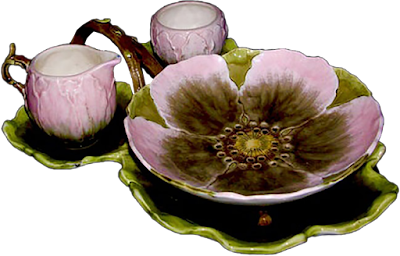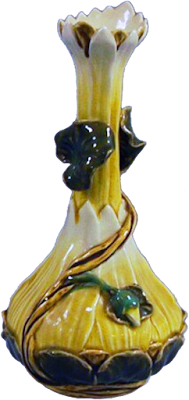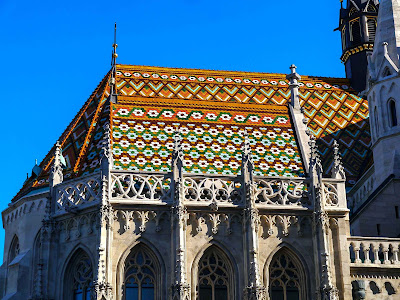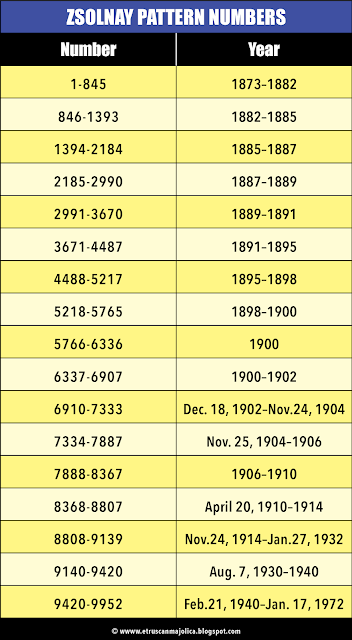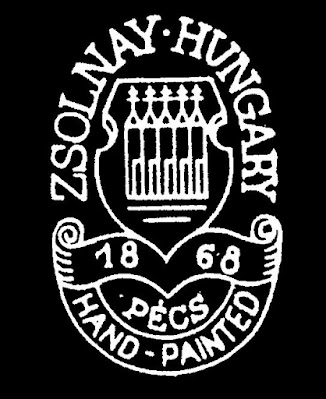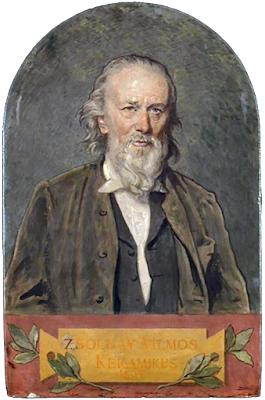Zsolnay majolica strawberry server
Today Zsolnay is best known for the brilliant iridescent eosine glazed pottery that is synonymous with its name, but the Zsolnay factory created a wide variety of ceramics during its history including majolica.
The Zsolnay Porcelain Factory was established in Pécs, in the southern part of Hungary by Miklós Zsolnay in 1853. Miklós was a salesman who began his career as a merchant selling a variety of different wares in his department store in Pécs. The success of the retail operation encouraged him to purchase a nearby architectural manufacturer that specialized in terracotta architectural brick.
Zsolnay factory entrance
The pottery began as an enterprise for Miklós’ son Ignác who had some training in pottery. Ignác expanded on the base of brick manufacture to include simple tableware, garden ornaments, architectural stoneware tile, stoves and plumbing fixtures. The pottery however was not successful, declaring bankruptcy twelve years into Ignác’s management. Ignác then left the business selling his interest to his brother Vilmós.
Ignác Zsolnay
Vilmós Zsolnay and his family
Vilmós Zsolnay was born in 1828 in the city of Pécs. In spite of an artistic sensibility, he followed his father into his business in sales at his father’s store. After the failure of his brother’s attempt at managing his father’s pottery he took over the management of the business in 1864, purchasing his brother's interest in 1865. Under him the company business grew, soon expanding into decorative pottery and more elegant tableware. He began to import raw materials from surrounding areas like Croatia and Transylvania as the business expanded. The stove and pipe operations soon separated into their own manufacturing businesses leaving the decorative and tableware unit an opportunity to develop independently.
Vilmós tried to raise the artistic level of the company's output by exhibiting in world exhibitions starting with the 1873 Vienna World's Fair. His first work was strongly inspired by the Orientalist movement. It was at the World’s Fair that he was first exposed to the colorful decorative majolica exhibited by Minton and Théodore Deck.
Vienna 1873 World's Fair
Ceramics exhibited by Théodore Deck in Vienna
Deck’s exhibition in Vienna 1873This encouraged him to develop his own majolica glazes at his Pécs workshop and soon developed majolica with designs based on popular tastes. Persian and Chinese design were the inspiration for much of Zsolnay's early work as was local Hungarian folk pottery. Vilmós’ daughters Júlia annd Térez were instrumental in the development of the company designs in the Japanese taste while classically trained sculptor Ármin Klein brought the western European interest in Renaissance art to the company. Son Miklós toured the middle east and brought Persian and Iznik ceramics back for inspiration before taking control of the company’s business operations.
Miklós Zsolnay
Júlia Zsolnay
Térez Zsolnay
At the Paris International Exhibition in 1878 Zsolnay made a strong impression in ceramics by exhibiting the company’s original ceramic creations. This won for the company the Gold Medal in its class as well as the Order of Honor of the French government. Their regular use of exhibitions to raise awareness of their work allowed the company to grow exponentially
Austro-Hungarian display at the 1894 Exhibition
featuring the work of Zsolnay
Zsolnay majolica Alhambra vase
Zsolnay majolica Persian vase
Zsolnay majolica pierced Persian vase
Zsolnay majolica Persian charger
Zsolnay majolica pierced vase
Zsolnay majolica Persian jardiniere
Zsolnay majolica Alhambra basket
Zsolnay majolica classical jardiniere
Zsolnay Renaissance Revival majolica urn
Zsolnay Renaissance Revival majolica urn
Zsolnay art nouveau floral vase
Zsolnay majolica art nouveau vase
Zsolnay majolica art nouveau vase
Zsolnay mouse match striker
Zsolnay majolica begonia tray
Zsolnay majolica Lotus vase
Zsolnay majolica Lotus plate
Zsolnay majolica Lotus tea tray
Zsolnay majolica Lotus charger
Zsolnay majolica Lotus toast rack
Zsolnay majolica Lotus covered dish
Zsolnay majolica Lotus jardiniere and pedestal
Zsolnay pattern book page for Lotus wares
Zsolnay majolica Lotus tea service
Zsolnay majolica Lotus coffee pot
Zsolnay majolica Lotus chocolate set
Zsolnay Lotus platter
Zsolnay majolica Lotus berry strainer
Zsolnay majolica Lotus chamber set
Zsolnay majolica standing gas lamp
Zsolnay majolica Lotus jardiniere and pedestal
Zsolnay majolica garden seat
Zsolnay majolica garden seat
Zsolnay majolica center bowl
Unusual Zsolnay majolica vase
Within a few years the Zsolnay factory became one of the largest potteries in Europe. Part of that dominance was a result of the company's architectural tile business. Throughout Hungary colorful Zsolnay pyrogranite majolica tiles decorate the exterior and interior of buildings, bringing brilliant unexpected color to roofs, facades and gardens. Today they are considered an integral part of Hungarian secessionist architecture.
Zsolnay majolica Renaissance Revival column
Roof of Matthias church
Zsolnay majolica garden ornament
Zsolnay garden
Zsolnay factory with majolica garden ornaments
Zsolnay pyrogrephic majolica architectural tile
The company interest in Persian and Ilznik pottery led to glaze experimentation that in 1893 brought the development of the eosine glaze that would make the pottery's name. Based on the secret lusterware technology of Fustat, Egypt, the glaze was first shown in 1896 at the National Millenium Exhibition in Budapest. It went on to win a gold medal at the 1900 Paris Exhibition.
Zsolnay eosine vase
Zsolnay eosine tray
Zsolney eosine tomato vase
Vilmós' son Miklós' took over the running of the factory around 1897 and oversaw the development of the eosine market. Vilmós Zsolnay, who had retired by that time, died in December 1900.
Vilmós Zsolnay in his later years
Vilmós Zsolnay on the factory grounds with his wife and three adult children
After the development of the eosine glaze, Zsolnay devoted much of its resources to the process allowing their majolica work to decline. A few pieces combined majolica glazes with the eosine glaze but soon majolica was discontinued in favor of the eosine process.
Zsolnay majolica and eosine vase
The company continued to prosper gaining fame for its Art Nouveau designed ceramics until war took over the European continent. WW1 had a devastating effect on the businesses of all of Europe. The collapse of the Austro-Hungarian government reverberated throughout the continent. The Zsolnay company lost much of its decorative and architectural business and survived through the manufacture of utilitarian electrical insulators. The Communist regime nationalized the factory in 1948 and the Zsolnay family lost their fortune as well as their interest in the business. The original decorative molds were then destroyed. The factory continued in operation creating porcelain, dinnerware and other utility ceramics but the heyday of the factory was over.
Marks
Zsolnay was generally not marked prior to 1878 however many pieces have a three or four digit number on the base that relates to the company design books. This allows us to date the production design of early Zsolnay.
The pattern number of 1050 shown here tells us that the piece that
bears this mark was designed between 1882 and 1885
A plain mark of Z.W.Pécs can occasionally be found on some pieces. The mark may also include the three initials TJM for Vilmós' three children Teréz, Júlia and Miklós.
After 1878 the company used a five tower trademark representing the five medieval cathedrals of Pécs.
Zsolnay majolica sometimes surprises people because the name is so closely associated with their porcelain products and eosine glaze, but the beauty of their majolica work and its craftsmanship match that of many of the finest manufacturers of Europe.
Vilmós Zsolnay

